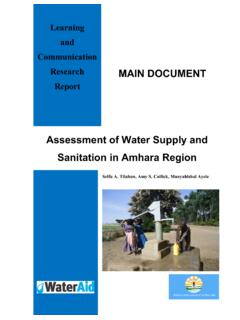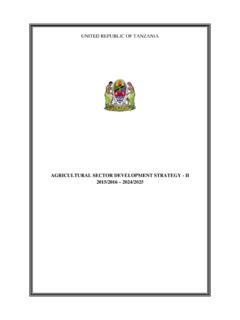Transcription of The Water-Energy-Food Nexus
1 The Water-Energy-Food Nexus A new approach in support of food security and sustainable agriculture The Water-Energy-Food Nexus A new approach in support of food security and sustainable agriculture food and Agriculture Organization of the United Nations Rome, 2014. Disclaimer The designations employed and the presentation of material in this information product do not imply the expression of any opinion whatsoever on the part of the food and Agriculture Organization of the United Nations (FAO) concerning the legal or development status of any country, territory, city or area or of its authorities, or concerning the delimitation of its frontiers or boundaries.
2 The mention of specific companies or products of manufacturers, whether or not these have been patented, does not imply that these have been endorsed or recommended by FAO in preference to others of a similar nature that are not mentioned. All photos FAO Mediabase This first version was produced in June 2014. Acknowledgements This note is the result of an FAO-internal consultative process led by the Land and water Division (NRL) and the Climate, energy and Tenure Division (NRC). It has been prepared by Olivier Dubois, Jean-Marc Faur s, Erika Felix, Alessandro Flammini, Jippe Hoogeveen, Lucie Pluschke, Manas Puri and Ol ay nver. Publishing arrangements and communication strategy were carried out by Nicoletta Forlano.
3 The graphic design and layout was done by James Morgan. Funding for FAO work on the Water-Energy-Food Nexus was provided in part by the OPEC Fund for International development (OFID) and the German Federal Ministry of Economic Cooperation and development (BMZ), which are gratefully acknowledged. I. 1 The Water-Energy-Food Nexus : Understanding and managing the complex interactions between water , energy and food water , energy and food are essential for human well-being, poverty reduction and sustainable development . Global projections indicate that demand for freshwater, energy and food will increase significantly over the next decades under the pressure of population growth and mobility, economic development , international trade, urbanisation, diversifying diets, cultural and technological changes, and climate change (Hoff 2011).
4 Agriculture accounts for 70 percent of total global freshwater withdrawals, making it the largest user of water . water is used for agricultural production, forestry and fishery, along the entire agri- food supply chain, and it is used to produce or transport energy in different forms (FAO 2011a). At the same time, the food production and supply chain consumes about 30 percent of total energy consumed globally (FAO 2011b). energy is required to produce, transport and distribute food as well as to extract, pump, lift, collect, transport and treat water . Cities, industry and other users, too, claim increasingly more water , energy and land resources, and at the same time, face problems of environmental degradation and in some cases, resources scarcity.
5 This situation is expected to be exacerbated in the near future as 60. percent more food will need to be produced in order to feed the world population in 2050. Global energy consumption is projected to grow by up to 50 percent by 2035 (IEA 2010). Total global water withdrawals for irrigation are projected to increase by 10 percent by 2050 (FAO 2011a). 1. As demand grows, there is increasing competition for resources between water , energy , agriculture, fisheries, livestock, forestry, mining, transport and other sectors with unpredictable impacts for livelihoods and the environment (FAO 2011c). Large-scale water infrastructure projects, for instance, may have synergetic impacts, producing hydropower and providing water storage for irrigation and urban uses.
6 However, this might happen at the expense of downstream agro-ecological systems and with social implications, such as resettlements. Similarly, growing bioenergy crops in an irrigated agriculture scheme may help improve energy supply and generate employment oppor- tunities, but it may also result in increased competition for land and water resources with impacts on local food security. The Water-Energy-Food Nexus in the Red River Basin in Vietnam A series of reservoirs in the upstream reaches of the Red River in northern Vietnam regulate flows and supply much of the electricity needed for Vietnam's modernization and industrialization strategies.
7 The same system is the sole water source for domestic uses and irrigation of almost 750 000 ha of rice- based farming in the Red River delta, which is critical to social stability and food security in Vietnam. Most of the irrigation systems in the delta use pumps, with electricity supplied by the reservoirs, to distribute water to the fields and other users within the irrigation systems. As water becomes scarce, and competition is growing between the energy and agricultural sectors, there is still a lack of reliable and policy-relevant data and information to guide water allocation choices. Effective cross- sectoral consultation mechanisms are needed to ensure the development of concerted efforts to address this problem, and to make sure that decisions on water release and allocation are taken as part of an integrated, long-term and 2 multi-sectoral strategy.
8 In this context, the Water-Energy-Food Nexus has emerged as a useful concept to describe and address the complex and interrelated nature of our global resource systems, on which we depend to achieve different social, economic and environmental goals. In practical terms, it presents a conceptual approach to better understand and systematically analyse the interactions between the natural environment and human activities, and to work towards a more coordinated management and use of natural resources across sectors and scales. This can help us to identify and manage trade-offs and to build synergies through our responses, allowing for more integrated and cost-ef- fective planning, decision-making, implementation, monitoring and evaluation.
9 The Water-Energy-Food Nexus describes the complex and inter-related nature of our global resources systems Nexus interactions are complex and dynamic, and sectoral issues cannot be looked at in isolation from one another. Importantly, they exist within a wider context of transformational processes or drivers of change that need to be taken into account. It is important to note that there are different conceptu- alisations of the Nexus that vary in their scope, objectives and understanding of drivers. Several concepts, frameworks and methodologies have looked at the interlinkages between water , energy and food (Mohtar and Daher 2012;. Bizikova et al.)
10 2013; ADB 2013; UN-ESCAP 2013), but also land and soil (ERD. 2012; Hoff et al. 2013), minerals (Andrews-Speed et al. 2012), and ecosystems (UNECE 2014; ICIMOD 2012).. It is about balancing different resource user goals and interests while maintaining the integrity of ecosystems 3. 2 What is the added-value of a Nexus approach? A cross-sectoral and dynamic perspective A Nexus approach helps us to better understand the complex and dynamic interrelationships between water , energy and food , so that we can use and manage our limited resources sustainably. It forces us to think of the impacts a decision in one sector can have not only on that sector, but on others.











